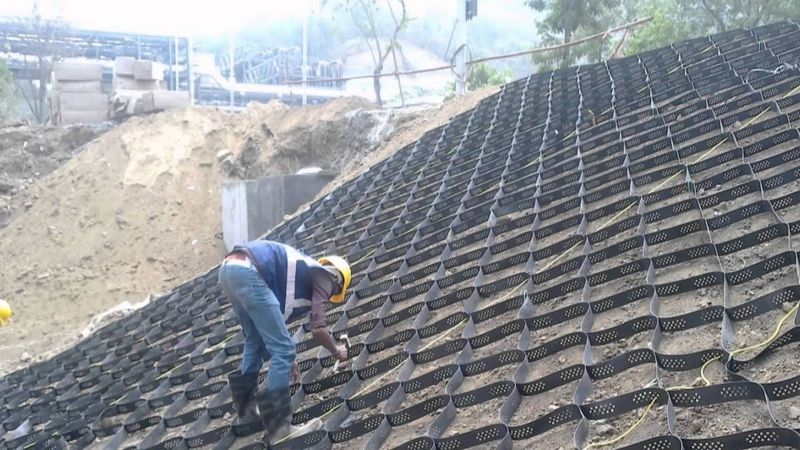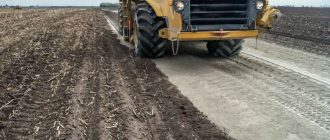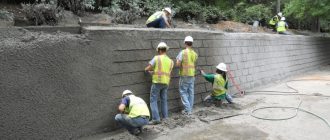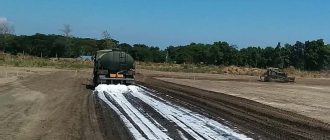
Preventing Erosion Through Advanced Soil Stabilization Strategies
Soil erosion is a significant issue that affects land all around the world. Through various strategies and techniques, it is possible to prevent erosion and promote sustainable land management.
One of the most effective ways of preventing erosion is through the use of advanced soil stabilization strategies. By implementing these strategies, landowners and managers can ensure the long-term stability of their soil and protect against erosion.
What are Advanced Soil Stabilization Strategies?
Advanced soil stabilization strategies are innovative methods that go beyond traditional erosion control techniques. These strategies focus on improving soil quality and structure to enhance its ability to withstand erosion.
Some of the key advanced soil stabilization strategies include:
– Implementing cover crops to protect the soil surface and reduce wind and water erosion
– Using bioengineering techniques, such as planting trees and vegetation, to stabilize slopes and prevent soil movement
– Applying soil amendments, such as organic matter and mulch, to enhance soil fertility and stability
– Employing erosion control structures, such as terraces and retaining walls, to redirect water flow and reduce erosion
By combining these strategies and implementing them in a holistic manner, land managers can effectively prevent erosion and preserve the health of their soil.
About Erosion
Erosion is a natural process that involves the wearing away of soil and rock due to the movement of wind, water, or ice. It is a major global environmental issue that can have devastating effects on land and water resources.
Strategies for preventing erosion are crucial for maintaining sustainable land management practices. The advanced soil stabilization strategies offered by this product are designed to effectively combat erosion and promote long-term soil health.
Through the use of innovative techniques and materials, our advanced stabilization strategies protect soil from the destructive forces of wind and water. These strategies prevent soil erosion by enhancing soil structure, increasing the stability of slopes, and promoting the growth of vegetation.
By preventing soil erosion, we can preserve the fertility and productivity of the land, protect water quality, and mitigate the environmental impacts of erosion. Our advanced soil stabilization strategies offer a sustainable solution to the problem of erosion, ensuring the long-term health and productivity of our land.
The Impact of Erosion
Erosion is a natural process that occurs when soil is displaced or removed from its original location. It is primarily caused by the forces of wind, water, and human activities. However, the impact of erosion goes far beyond the loss of soil. It can lead to significant environmental and economic consequences that affect both rural and urban areas.
One of the key effects of erosion is the loss of fertile soil. Productive agricultural lands are at risk of losing their topsoil, which is rich in nutrients and essential for plant growth. As soil is eroded, it becomes less capable of supporting crops, leading to reduced agricultural productivity and potential food shortages. This not only affects farmers but also has a broader impact on food security and global food prices.
Erosion also has severe consequences for water quality. When soil is washed away by rainfall or runoff, it can contaminate nearby water sources, such as rivers, lakes, and groundwater. Sediments in the water can suffocate fish and other aquatic organisms, disrupt ecosystems, and degrade water quality for human consumption. This poses a significant threat to biodiversity and public health.
Moreover, erosion can worsen the impact of natural disasters such as floods and landslides. Areas with eroded soil are more susceptible to flooding as water can easily penetrate the ground instead of being absorbed. Additionally, steep slopes without proper soil stabilization strategies are prone to landslides, which can cause property damage, loss of life, and further soil erosion.
Preventing erosion is a critical step in achieving sustainable land management. Advanced soil stabilization strategies, through techniques such as terracing, contour plowing, and planting cover crops, can help mitigate erosion and maintain soil health. By implementing these strategies, we can protect our agricultural lands, preserve water quality, and reduce the risk of natural disasters.
| Soil Loss | Food Security | Water Contamination | Natural Disasters |
| Reduced Agricultural Productivity | Global Food Prices | Suffocate Aquatic Organisms | Flooding |
| Erosion of Topsoil | Loss of Nutrients | Disrupt Ecosystems | Landslides |
Understanding Soil Stabilization
Soil erosion is a significant problem that can have detrimental effects on the environment and land productivity. Advanced soil stabilization strategies play a crucial role in preventing erosion and promoting sustainable land management.
Soil stabilization involves various techniques and methods aimed at improving the stability and strength of the soil. These strategies are designed to enhance the resistance of soil to erosion and other forms of degradation.
One of the key aspects of soil stabilization is the understanding of soil properties and their impact on erosion. Different soil types have different characteristics, such as texture, composition, and drainage capacity, which determine their susceptibility to erosion.
Through advanced soil stabilization strategies, the erosion of soil can be effectively prevented. These strategies may include the use of erosion-control blankets, geotextiles, and vegetative measures, among others.
Erosion-control blankets are made of materials that allow water and air to penetrate the soil while reducing the velocity of runoff water, thus preventing erosion. Geotextiles, on the other hand, are synthetic fabrics that are placed within the soil to increase its stability and resistance to erosion.
In addition, vegetative measures involve planting vegetation, such as trees, shrubs, and grasses, to stabilize the soil and create a protective cover. The roots of plants help bind the soil particles together, reducing the risk of erosion.
By understanding soil stabilization and implementing advanced strategies, we can effectively prevent erosion and ensure sustainable land management. This not only protects the environment but also promotes the long-term productivity and viability of the land.
Sustainable Land Management
Stabilization of soil through the implementation of advanced erosion prevention strategies is a crucial aspect of sustainable land management. As the Earth’s population continues to grow, the demand for land resources increases, making it imperative for us to manage our land in a sustainable and responsible manner.
Erosion poses a significant threat to our land and its resources. It occurs when soil is displaced by wind, water, or human activities, leading to the loss of topsoil, essential nutrients, and ecosystem services. However, with the utilization of advanced stabilization strategies, we can prevent erosion effectively.
By implementing soil stabilization techniques such as contour plowing, terracing, and vegetation management, we can ensure that our land remains stable and productive in the face of environmental challenges. These strategies help to reduce the impact of water and wind erosion, promoting the retention of soil particles and organic matter.
Contour plowing involves plowing along the natural contours of the land to create ridges and furrows. This method helps to slow down the flow of water, reducing erosion and increasing water infiltration into the soil. It also helps to prevent runoff and soil loss during heavy rain events.
Terracing is another effective method for preventing soil erosion. It involves creating level platforms on steep slopes, which trap sediment and slow down water runoff. Terraces help to reduce the slope gradient, preventing the formation of gullies and preventing soil erosion.
Vegetation management is a critical aspect of sustainable land management. By planting and maintaining vegetation cover, we can stabilize the soil and promote root growth, locking in soil particles and preventing erosion. Vegetation acts as a natural barrier against wind and water erosion, reducing the impact of these forces on the land.
In conclusion, sustainable land management requires the implementation of advanced strategies for soil stabilization. By preventing erosion through the use of contour plowing, terracing, and vegetation management, we can ensure the long-term productivity and sustainability of our land resources.
The Importance of Sustainable Land Management
Sustainable land management plays a crucial role in preventing erosion and maintaining the health of our soil. Through advanced strategies, we can not only mitigate erosion but also promote soil stability and long-term sustainability.
Erosion is a natural process that can be accelerated by human activities such as deforestation, improper agricultural practices, and urbanization. This can lead to the loss of fertile topsoil, decreased water holding capacity, and reduced biodiversity.
By implementing advanced soil stabilization strategies, we can prevent erosion and its negative impacts. These strategies involve the use of vegetation, such as grasses and trees, to anchor the soil and reduce the impact of precipitation and wind. Additionally, contour plowing, terracing, and other techniques can be applied to control the flow of water and reduce erosion.
Preventing erosion is essential for sustainable land management because soil is a finite resource that takes centuries to form. Healthy soil supports plant growth, provides essential nutrients, and plays a vital role in carbon sequestration. Erosion can disrupt this delicate balance, leading to decreased agricultural productivity and increased environmental degradation.
Moreover, sustainable land management practices contribute to the preservation of ecosystem services and the overall health of our planet. By preventing erosion, we protect water quality, reduce sedimentation in rivers and lakes, and maintain biodiversity. These benefits extend beyond agricultural areas, positively influencing urban environments and natural habitats as well.
In conclusion, sustainable land management, through advanced soil stabilization strategies, is crucial for preventing erosion and preserving the health of our soil. By implementing these strategies, we can ensure the long-term sustainability of our land, promote agricultural productivity, and protect the environment for future generations.
Erosion Prevention Techniques
Preventing soil erosion is essential for sustainable land management. Through advanced soil stabilization strategies, we can protect our land and ensure its long-term productivity.
One effective technique for erosion prevention is contour plowing. This method involves plowing along the slopes of the land, creating ridges and furrows that slow down water flow. By breaking up the soil, contour plowing helps to prevent the loss of topsoil and reduces erosion.
Another successful strategy is the use of erosion control blankets or mats. These blankets are made from biodegradable materials and are placed on the soil surface. They help to stabilize the soil and prevent erosion by reducing surface runoff, promoting infiltration, and protecting the soil from wind and water erosion.
Cover cropping is also an important technique for preventing erosion. By planting a cover crop during fallow periods, we can protect the soil from erosion caused by wind and water. The cover crop helps to hold the soil in place, reduce surface runoff, and improve soil structure.
Additionally, terracing is an effective method for preventing erosion on sloping land. Terraces are constructed by creating a series of level steps or platforms on the slope. These terraces help to slow down water flow and reduce erosion by capturing and storing water on each level, preventing it from rushing down the slope.
Overall, implementing these advanced soil stabilization strategies and erosion prevention techniques is crucial for maintaining healthy, productive land. By taking proactive measures to prevent erosion, we can ensure the sustainability of our land and preserve it for future generations.
Advanced Soil Stabilization
Preventing erosion is crucial for sustainable land management. Through advanced soil stabilization strategies, we can minimize the risk of soil erosion and promote the long-term viability of our lands.
Soil stabilization involves implementing various techniques and measures to improve the strength, durability, and permeability of the soil. These strategies help to mitigate erosion and prevent the loss of valuable topsoil.
1. TerracingTerracing is a technique that involves creating level platforms, or terraces, on slopes. This helps to slow down water runoff, allowing it to infiltrate into the soil and preventing surface erosion. By implementing terracing, we can control the flow of water and reduce the erosive power of rainfall. |
2. Vegetative CoverPlanting vegetation, such as grasses, shrubs, or trees, is another effective strategy for soil stabilization. The roots of these plants help to bind the soil together, making it more resistant to erosion. Vegetative cover also helps to absorb excess water, reducing runoff and preventing erosion. |
3. Erosion Control BlanketsErosion control blankets, also known as erosion control mats or geotextile blankets, provide immediate protection to bare soil surfaces. These blankets are made of biodegradable materials, such as straw or coconut fibers, and help to stabilize the soil by preventing erosion caused by wind and water. |
4. Soil ReinforcementSoil reinforcement techniques, such as the use of geosynthetics, can significantly increase the strength and stability of the soil. Geosynthetics, such as geogrids and geotextiles, are synthetic materials that are placed within the soil to provide additional support. They help to distribute loads and reduce the risk of soil movement or failure. |
By implementing these advanced soil stabilization strategies, we can effectively prevent erosion and ensure the sustainable management of our lands. It is essential to prioritize the conservation of soil resources for the long-term health and productivity of our ecosystems.
Innovative Soil Stabilization Methods
Soil erosion is a critical issue that requires effective measures for preventing its detrimental effects on land management. Traditional soil stabilization strategies have been employed for years, but innovative methods are emerging to address this challenge more efficiently.
One such method is the use of geotextiles, which are permeable fabrics that are placed on the soil surface to reinforce it and prevent erosion. These geotextiles act as a barrier, allowing water to filter through while keeping the soil particles in place. This strategy not only stabilizes the soil but also helps in creating a nurturing environment for plant growth.
Another innovative method is the application of bioengineering techniques. This involves using living plants to stabilize the soil. By strategically planting trees, shrubs, or grasses in eroded areas, their root systems work as natural anchors, holding the soil together. The root systems also help in increasing the soil’s water-holding capacity and nutrient content, leading to improved land productivity.
Additionally, advancements in nanotechnology have opened up new possibilities for soil stabilization. Nano-sized particles, such as nanoparticles of clay minerals, can be added to the soil to enhance its stability. These particles act as bonding agents, increasing the soil’s cohesion and reducing its susceptibility to erosion. This approach is promising for sustainable land management practices.
In conclusion, preventing soil erosion and ensuring sustainable land management require innovative soil stabilization methods. Geotextiles, bioengineering techniques, and nanotechnology are just a few examples of strategies that can be employed to safeguard our valuable soil resources. By implementing these innovative approaches, we can protect our land and promote a more sustainable future.
The Role of Technology
Technology plays a crucial role in the prevention of soil erosion through advanced stabilization strategies. With the rapid advancement of technology, we now have access to innovative tools and techniques that can effectively protect soil from erosion, ensuring sustainable land management.
Soil erosion is a major concern for agricultural practices and land development projects. However, through the use of advanced technology, we can mitigate the risks associated with erosion and implement effective soil stabilization measures.
One of the key technologies in preventing soil erosion is remote sensing. By utilizing satellite imagery and other remote sensing techniques, we can identify areas at high risk of erosion and take timely action to prevent it. This allows us to prioritize conservation efforts and allocate resources where they are most needed.
Geosynthetics are another technological solution for soil stabilization. These synthetic materials, such as geotextiles and geogrids, are designed to reinforce the soil and prevent erosion. When properly installed, geosynthetics create a barrier that enhances soil stability and reduces the impact of erosive forces.
Slope stabilization technologies are also crucial in preventing erosion on hilly terrains and steep slopes. Techniques such as terracing, retaining walls, and slope reinforcements provide structural support that prevents soil movement and minimizes erosion risks.
Furthermore, precision agriculture technologies offer innovative ways to optimize soil management and minimize erosion. By utilizing sensors, data analysis, and automation, farmers can precisely monitor soil conditions, determine optimal irrigation and fertilization levels, and prevent excessive soil erosion caused by overwatering or improper nutrient application.
In summary, technology plays a critical role in preventing soil erosion through advanced stabilization strategies. From remote sensing and geosynthetics to slope stabilization and precision agriculture, these technological solutions offer effective and sustainable approaches to protect soil and promote sustainable land management.
Benefits of Advanced Soil Stabilization
Implementing advanced soil stabilization strategies offers numerous benefits, particularly in preventing erosion and promoting sustainable land management. By applying these techniques, landowners can protect their property and ensure long-term environmental stability.
| Preventing erosion | One of the primary benefits of advanced soil stabilization is its ability to prevent erosion. By stabilizing the soil, it becomes more resistant to the forces that cause erosion, such as wind and water. This not only protects the land itself but also helps maintain the quality of nearby water sources. |
| Promoting vegetation growth | Advanced soil stabilization strategies create an environment that is conducive to vegetation growth. By preventing erosion, soil is better able to retain moisture and nutrients, providing an ideal foundation for plants to thrive. This not only enhances the aesthetics of the land but also supports biodiversity and ecological balance. |
| Increasing land durability | Stabilizing the soil using advanced techniques improves its durability and longevity. This is particularly important in areas prone to natural disasters, such as floods or landslides. By implementing soil stabilization strategies, landowners can better protect their property and reduce the risk of damage from such events. |
| Reducing maintenance costs | By preventing erosion and increasing land durability, advanced soil stabilization strategies can significantly reduce the need for costly repairs and maintenance. This not only saves landowners money but also reduces the environmental impact associated with repairing damaged land. |
| Preserving soil fertility | Soil stabilization helps preserve the fertility of the land by preventing erosion and promoting healthy soil composition. This is essential for sustainable land management, as it supports agricultural productivity and the long-term viability of the land for future generations. |
Overall, investing in advanced soil stabilization strategies is a wise choice for landowners looking to prevent erosion, promote sustainable land management, and ensure the longevity of their property. Implementing these techniques not only protects the land and surrounding environment but also offers long-term financial savings and supports biodiversity.
Improved Long-Term Soil Health
Effective soil stabilization is essential for preventing erosion and ensuring sustainable land management. Our advanced strategies focus on enhancing the long-term health of soil, promoting its stability and resilience against various environmental stressors.
Through a comprehensive approach, we employ innovative techniques to address soil degradation and prevent erosion. By implementing advanced soil stabilization strategies, we can improve the overall health of soil and preserve its natural fertility.
Our soil stabilization methods involve a combination of physical, chemical, and biological approaches. We use cutting-edge technologies to strengthen soil structure and enhance its nutrient-retention capacity. This helps prevent soil erosion by reducing water runoff and promoting the absorption of water into the soil.
Additionally, our strategies promote the growth of beneficial microorganisms in the soil, which play a crucial role in nutrient cycling and organic matter decomposition. This further contributes to the improvement of soil health and fertility.
By implementing our advanced soil stabilization strategies, you can protect your land from erosion, improve long-term soil health, and ensure sustainable land management practices. Contact us today to learn more about our effective soil stabilization solutions.
Frequently asked questions:
What is the book “Preventing Erosion: Advanced Soil Stabilization Strategies for Sustainable Land Management” about?
The book “Preventing Erosion: Advanced Soil Stabilization Strategies for Sustainable Land Management” provides comprehensive information on advanced strategies for soil stabilization to prevent erosion and promote sustainable land management practices.
Who is the author of the book “Preventing Erosion: Advanced Soil Stabilization Strategies for Sustainable Land Management”?
The book “Preventing Erosion: Advanced Soil Stabilization Strategies for Sustainable Land Management” is authored by experts in the field of soil science and land management. The specific author of the book may vary depending on the edition or version.
What are some of the soil stabilization strategies discussed in the book?
The book “Preventing Erosion: Advanced Soil Stabilization Strategies for Sustainable Land Management” covers a wide range of soil stabilization strategies including terracing, contour plowing, cover cropping, mulching, and bioengineering techniques. It also provides information on the latest research and technological advancements in soil stabilization.
Is the book suitable for beginners or is it more advanced?
The book “Preventing Erosion: Advanced Soil Stabilization Strategies for Sustainable Land Management” is primarily targeted towards professionals and individuals already familiar with basic soil science and land management principles. However, it may still be useful for beginners who are interested in learning about advanced soil stabilization strategies and their application in sustainable land management.
Are there any case studies or real-life examples included in the book?
Yes, the book “Preventing Erosion: Advanced Soil Stabilization Strategies for Sustainable Land Management” includes numerous case studies and real-life examples to illustrate the effectiveness and practical application of different soil stabilization strategies. These case studies provide valuable insights and help readers understand how these strategies can be implemented in different scenarios.
What is the book about?
The book is about advanced soil stabilization strategies for sustainable land management and preventing erosion.






